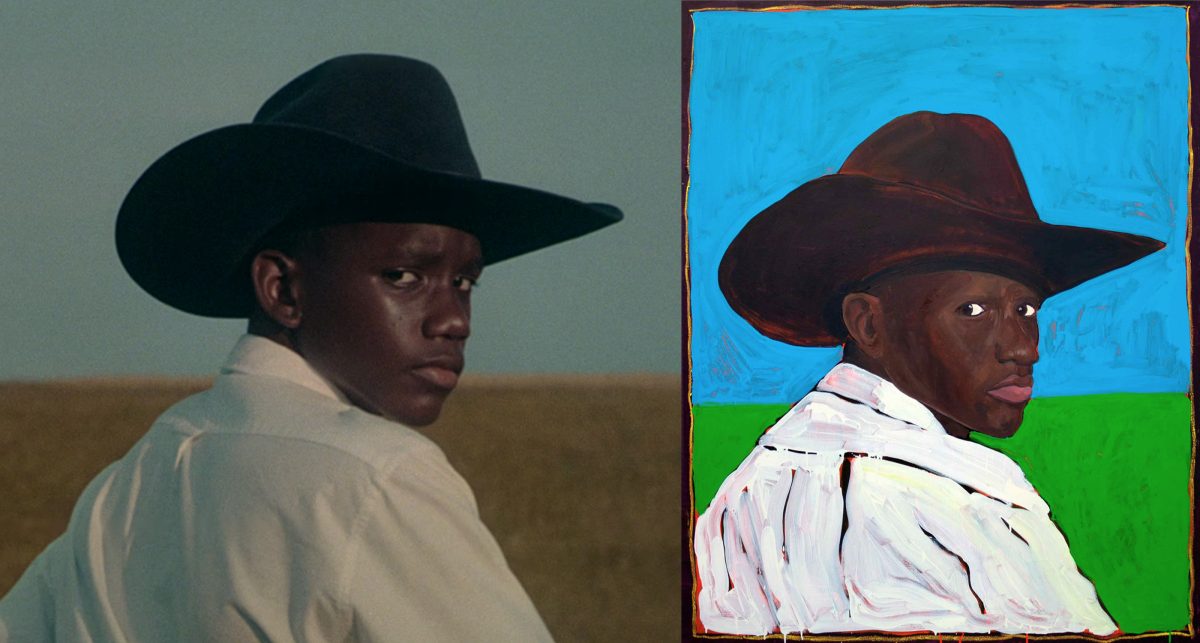

A painting currently on view at the Guggenheim Museum in Bilbao depicts a Black figure in a cowboy hat glancing over his shoulder against an abstract background of field and sky. The stark composition, painted by Basque artist Gala Knörr, is nearly identical to an image captured by the Brooklyn-based photographer and filmmaker known as dayday — a still from her 2022 short film Blue.
The movie, directed by dayday and filmed in North Carolina, is a portrait of Ezekiel Mitchell, one of the best professional bull riders in the world. Through visually stunning footage and personal accounts from Mitchell, nicknamed “Blue,” the film chronicles his start in rodeo and his plans to become the first Black rider to win a world title in nearly four decades. The film’s hazy light and soft palette, expertly capturing the crispness of a white shirt and the red earth of the rodeo ground, are vastly different from the bright hues of Knörr’s work, but the resemblances are otherwise uncanny.
Listen beautiful relax classics on our Youtube channel.
The similarities were picked up on by social media users, who decried that Knörr’s painting “Young Cowboy” (2022) and other canvases by the artist in the Guggenheim’s Basque Artist Program exhibition made no reference to dayday in their titles or promotional material. The criticism was further amplified on TikTok, where videos by art consultant and curator Alexis Hyde and user Bona Bones called out Knörr’s paintings as “blatant ripoffs” of the work of dayday, a self-described Black and queer artist. Dayday’s credentials are impressive, including work for an ABC series on the exhibition Soul of a Nation, a design concept for the New York Times, and branding for Alicia Keys’s Masterclass series.
A text on the Guggenheim’s website describes “Young Cowboy” as Knörr’s attempt to revise the archetypal narrative of the American West by pointing to its roots in “colonialism and in a mixture of races, cultures, and provenances.” According to the text, which does not mention dayday or Blue, the painting was “inspired by the image of the young Afro-American Brianna Noble on horseback,” a photograph from a Black Lives Matter protest in Oakland that went viral in 2020.
Knörr’s painting echoes the subject matter of dayday’s film, not just its form. In one scene in Blue, Dr. Demetrius W. Pearson, a professor at the University of Houston, laments the way in which rodeo culture has failed to recognize Black individuals. “It’s unfortunate that the legacy of African American cowboys and their contributions have been not only blatantly omitted, but often times whitewashed, from the annals of American history,” he says.
A spokesperson for the Guggenheim Bilbao told Hyperallergic that a resolution had been reached: Dayday, Knörr, and the exhibition’s curators have agreed to display the work along with an artist statement “marking the visible source of inspiration for Knörr.”
“By tangibly linking the works together, we can begin to reflect on the dual erasure of the cowboys of the Basque country and African-American cowboys in the United States from history,” the spokesperson said. Dayday and Knörr did not respond to Hyperallergic’s requests for comment.
Knörr’s gallery in New York, Pablo’s Birthday, also released a statement on its Instagram page, apologizing to dayday and inviting users to follow their work.
“We believe in giving credit where credit is due and want to encourage a space for collaboration of all capacities,” the gallery said. “As for Gala we want to acknowledge the pathways in which she got to where she is and urge cultural institutions such as galleries and museums and artists themselves to reflect on their practices and the impact they have and to notice how their privileges have led them to where they are.”
In an August 2021 Instagram post, the gallery situated Knörr’s work at the intersection of “identities and technology,” pointing to her use of the media, popular culture, and digital images in sometimes tongue-in-cheek ways. Indeed, other works by the artist evince her interest in found material, like a celebrity photograph, not unlike well-known artists such as Richard Prince. But the recent controversy exposes the limits of appropriation in art, throwing into sharp relief how the strategy beloved by postmodernists can lead to the obfuscation of artists from historically underrepresented groups.
Rebecca Polanzke, a New York-based gallery worker who was vocal on social media, opined that the incident “feeds into the ever present exploitation of black art by white savior figures.”
“The blatant plagiarism by Gala Knörr isn’t empowering or offering a platform to these artists or their histories — especially if giving proper credit to the original artist is so difficult,” Polanzke told Hyperallergic.
Polanzke added: “If institutions like the Guggenheim really love how evocative her work is, why not exhibit the original artist or one of the many figurative Black artists that are establishing themselves the art world?”
Source: Hyperallergic.com